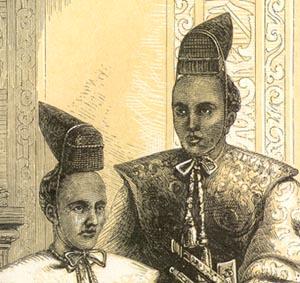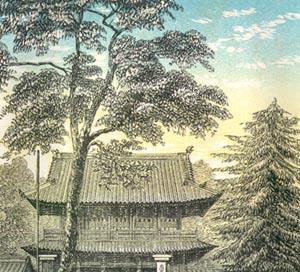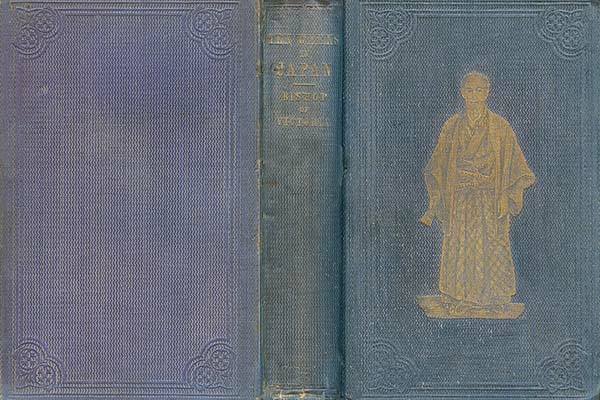Chapters (Main title - complete, subsections - comprehensive but partial listing):
- Introduction. Relative Importance of Japan, Former intercourse with surrounding countries, Arrival of Roman Catholic Missionaries, Repulse of Tarter invasions.
- Arrival at Nagasaki. Voyage from Shanghae to Nagasaki, Lodging in Budhist temple, View of city and harbour, British Consulate, Dutch factory, Former Japanese arrogance and humiliations of Dutch, Their imprisonment in Deshima.
- City of Nagasaki. Street scenes and native trades, Grand religious holiday, A Japanese preacher, Popular respect for priesthood.
- Religions in Japan. Visit to a Sinto temple, Leading religions in Japan, Tolerant spirit of Government, Sooto, or Confucian moralists, Sintoism, Roman Catholic and Budhist remembrances.
- Local Government of Nagasaki. Visit to the Governor of Nagasaki, System of dualism, Spies, Independence of foreign products, Obstructions to growth of foreign commerce.
- City of Nagasaki. Local Chinese factory and commercial guild, European sailors, Superior cleanliness of Japanese streets, Semi-nudity of people, Oil-paper coats, Frequent conflagrations, Quack medicines, Medical practitioners.
- Scenes of Japanese Life. Statuaries, Schools, Budhist prejudice against slaughtering of animals, Ordinary vehicles, Kagoo, Loo chooan experience, Severe laws, Public bathing-houses, Non-seclusion of Japanese wives.
- Popular Customs. Marriage custom of Japanese, New-year holidays, Five great national festivals, Budhist purgatory, Flying kites, Minstrels, Street comedies.
- Japanese Drama. Superior class of theatrical exhibition, Actors, Scenes, National tragedy, Harakari, Japanese ideas on legal suicide, Disregard of death.
- Funeral Ceremonies. Mortuary and funeral rites of Japanese, Coroner's inquest, Mode of sepulture, Posthumous names, Ancestral tablet, Accounts of Dutch writers, Period of mourning and defilement, Fear of ghosts.
- Native Visitors. Scenes of temple life, The priest of Rin-Shan, Impartiality of Japanese law, Priest visitors, Two sworded officers, Doctor Kasatu, A Japanese surgery, Universal thirst for information and purchase of foreign books.
- Burial Districts Near Nagasaki. Excursions into surrounding villages, Restive horses, Anglo-French Commissariat from China, Rural Scenery, Governor's aquatic gala, Tokitz, Material comfort of population, Yeddo Road, Refectory-houses, Trip over the Hills, Japanese Flora, Agriculture, Villages.
- Former Religious Persecutions. Fort of Simabara, Papenberg, Earthquakes, Persecutions, Francis Xaiver, Roman Catholic expulsion, Dutch complicity, Trampling on cross, Inscription over slaughtered Christian's place of sepulture.
- A Budhist Commemoration. Colonel von Siebold, Grand commemorative Budhist festival, Horenji Monastery, A national hero in the Corean war, Hospitality of the priests, Process of children, Priests, Abbot, Liturgical service, Sermon, Religion wearing a holiday dress, Ineffectual moral restraint.
- Statistics of Local Health and Trade. Dr Pompe von Meerdervoort, Medical School, Japanese class, Lectures, Naval School, Different classes of native population, Sanitary conditions, Moral state, Climate of Nagasaki, Consular statistics of trade.
- Closing Incidents of Stay in Nagasaki. Japanese Engine-factory, Diving-bell, Hopefulness of Japanese race, European cemetery, Farewell Sunday service among Europeans.
- Voyage to Kanagawa. Voyage along the Japanese coast, Kewsew, Sikok, Niphon, Simoda, Bay of Yeddo, Arrival at Kanagawa, Yakoneens, Visit to Yokuhama, Mount Fusi, Moral condition of European settlement, Currency questions, British Envoy's despatch.
- Incidents at Yokuhama and Kanagawa. Streets at Yokuhama, Recent assassination of two Dutch captains, Prince of Mito, Excess of individual foreigners, Feeling towards native races, A Chinese in Difficulty, Local custom-house, Secret obstacles to foreign trade, Kanagawa, Earthquake, Surrounding country, Japanese guards.
- Arrival at Yeddo. Journey to Yeddo, Scenes on the way, Kawasati, River Loco, Public refectory-house, Female attendants, Sinagawa, Approach to Yeddo, British Legation, Earthquake.
- Imperial Government of Japan. Historical sketch of Japanese Government, Spiritual and secular Emperors, Tyco-Sama, The Mikado a political nonentity, Absorption of power into the Tycoon, The increased power of the great Council of State, A plurality of mayors of the palace, The great Daimios of the Empire, Recent Feuds, Dualism and system of mutual control.
- Rides Through the City of Yeddo. Excursion into the city, 'Official quarter', Citadel moat, Scene of Goteiro's assassination, Details of Plot, Tycoon's palace enclosure, Places of Diamios, Excursion into the 'commercial quarter,' 'Nipon-bas,' Scenes in streets, Panorama of Yeddo, Estimated population, Monasteries, Beggars, Pilgrims.
- Foreign Legations in Yeddo. American Consul-General, Recent treaties, Japanese ministers of foreign affairs, Japanese embassy to United States, 'Temple-lords," Higher class priesthood, Prospective toleration of Christianity, French Charge d'Affairs, Abbe Girard, Yakoneens.
- The Loochoo Islands. Nature of Loochooan dependency upon Japan, Captain Basil Hall's account. Loochoo naval mission, Early difficulties of missionaries, Embarrassment of native government, Passive resistance, Abandonment of mission, Author's visit to Loochoo in 1850, Loochoo a fief of the Japanese principality of Satsuma, Biennial tribute-junk to China, Character and appearance of people, Explanatory official despatch from the Regent of Loochoo, His historical and statistical facts respecting the Loochoo Islands, The French mission, Liberal policy of the late Prince of Satsuma (this chapter is 20 pages long with one plate)
- The Territorial Princes of Japan. Their relative power to the central government. Extent of respective limits of subjection, independence and territorial revenue, Numerous armed retainers, Families of princes continually resident in Yeddo, Occasional defiance among their number, List of the richest Daimios with amounts of territorial income.
- Excursion to Oji. Suburban beauties of Yeddo, Villages and gardens, Moat of citadel, Palaces of the grandees, The 'Imperial Brothers.' Prince of Kii, Prince of Owari, Prince of Mito, Prince of Kanga, the wealthiest Daimio and head of the conservative party, Richly cultivated country, Refectory-house at Oji, Inconsiderable rivers in Japan, Imperial archery-ground, Tycoon's shooting box, Raincoats, Return through the 'commercial quarter.'
- Purveyors of Public Amusement. Vast numbers of idle population among the princes and their retainers, Wrestlers, play actors, and jugglers, Masquerades, Spinning tops, Acrobats, A celebrated juggler's exhibition of skill at the British Legation, The butterfly scene
- The Japanese Written Language. Mr. Rutherford Alcock's grammar of the Japanese language, Chinese system of ideographic symbols, Two indigenous systems of Japanese phonetic syllabarium, Hiragana character, Katagana character, Kaisho style of writing Chinese symbols, Giosho, Losho, Koye mode of reading Chinese, Kung, Total dissimilarity of Japanese and Chinese spoken languages.
- Local Objects of Public Interest at Yeddo. Primary and secondary schools for youth. Confucian textbooks, Academics, Military and naval schools of exercise, Medical schools, System of diplomas, Nosology, Dissection of human subjects, Gold-mines, Temptations to foreigners, Breach of custom regulations, Smuggling, Venal connivance of native officials at Yokuhama, Special dangers created by unprincipled foreigners.
- Departure from Yeddo. Return from Yeddo to Kanagawa, Sunday service among Europeans at Yokuhama, Oppressive treatment of natives connected with foreigners, Budhist college for training priests, Peculiar mode of burning off the ears of ripe corn, Intemperance, Total abstinence vow of the god Kompria, No slave caste, Strict registration, Good conduct in recent cases of foreign wrecks, Edict of deportation against Chinese at Yokuhama, Local trade, Summary view of missionary Openings.
- Departure from Japan. Brief notice of Hakodadi, Voyage to California port of San Francisco, Local excitement at arrival of Japanese embassy, The author's public letter to Judge M'Alister on local oppressiveness of American law against the Mongolian race. Probable early connection between Japanese race and some of the North-West American Indian Tribes, Letter of Lieutenant Brooke, U.S.N. to Secretary Toucey, Conclusion.
Type of Illustrations. I have seen the plates in this book called lithographs. I am not sure that is technically correct. It is clear that the basic plate images are woodcut engravings. The author notes in his forward:
The Author desires to express his acknowledgment of Messrs. Negretti and Zambra's kind permission to use some of their valuable photographic 'Views in Japan' in the pictorial illustrations of this work. Five of the eight wood-cuts were taken from their photographs, by M.G. Pearson. (at page vi, emphasis added)
Five of the plates are believed to be from photographs taken in Japan in 1859~1860 by Pierre Rossier. They were later published (November or December of 1861) as views of Japan by Negretti and Zambra.
All eight illustrations have some form of color added. I suspect it was done by a mechanical process or perhaps by hand using some type of stenciling technique. The following pictures provide close-up views of some of the illustrations.


(Multi-color)
The prints all have discolored borders.
 The discoloration never intrudes into the image area. I believe that this condition was a result of the process used to manufacture the tinted/colored woodcut engravings.
The discoloration never intrudes into the image area. I believe that this condition was a result of the process used to manufacture the tinted/colored woodcut engravings.
Listing of Illustrations (facing page indicated):
- The Japanese Embassy at Washington:--Simme-Bujen-no-kami, First Ambassador; Muragake-Awage-no-kami, Second Ambassador (Frontispiece)
- A Japanese official gentleman (page 66)
- A Japanese family scene in common life (page 108)
- Japanese ladies (page 166)
- A scene in a Japanese dwelling of the better class (page 266)
- Approach to the British Legation at Yeddo (page 281)
- A Loochooan gentleman and priest (page 342)
- Japanese houses on the shore in Yeddo harbour (page 396)
Map. Map illustrative of Japan and the adjacent countries (page 1)
Bishop George Smith. In order to develop missionary work in Hong Kong and other parts of China, the Church of England established the Diocese of Victoria in 1849. The Right Reverend George Smith was consecrated as its first bishop and arrived in Hong Kong in 1850. The boundaries of the Diocese of Victoria were extensive and included Hong Kong, China and Japan. Bishop Smith traveled extensively and authored several books relating to his travels.
Bishop Smith visited Loo Choo (Okinawa) in October of 1850. He wrote a book about that visit (Lewchew and the Lewchewans: Being a Narrative of a Visit to Lewchew or Loo Choo, in October, 1850) which was published in 1853. Smith inserted a chapter about the 1850 visit to Okinawa in this book. It is Chapter XXIII which is 20 pages long with one illustration. In this chapter he outlines the rejection of Dr. Bettelheim by the Loo Choo authorites. He then paints a fairly bleak picture of life in Okinawa in 1860 which is based upon accounts he has received from Protestant and Catholic missionaries.
Smith had a keen eye for the darker side of human nature and did not hesitate to point out mans' failings and weaknesses. He gives an interesting account of prostitution in Yokohama in these terms:
...they (Japanese officials) have endeavored to render Yokohama an attractive locality to young unmarried foreigners by establishing at the edge of the settlement and on a site approached by a narrow drawbridge over the canal, one of those infamous public institutions which have been already adverted to, containing its two hundred female inmates dispersed over a spacious series of apartments and all under government regulation and control. Not content with these flagitious methods of corrupting the foreign residents, the native officials contributed every facility for the perpetration of domestic vice and impurity. Young men were encouraged to negotiate through the custom-house the terms of payment and selection of a partner in their desolate mode of living. It is feared that the snare has not been set in vain; and Kanagawa was represented to me by persons generally well informed on local matters, as a deplorable scene of demoralisation and profligate life. (page 251)
Collation. Full Title: Ten Weeks in Japan, Short Title Page, Frontispiece, Full Title Page, Preface (2 pages), Contents (9 pages), List of Illustrations, Lithographed Fold-out Map of Japan with Coast Outlined in Blue (large - 3 folds out, 1 fold up, 13 1/2 x 15 in), Contents (numbered pages 1-442), Index (numbered pages 443-459). Published by Longman, Green, Longman and Roberts, London - Printed by Spottiswoode and Co, London.
|

